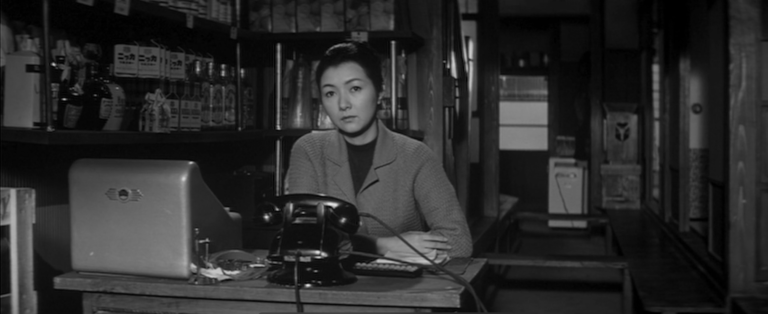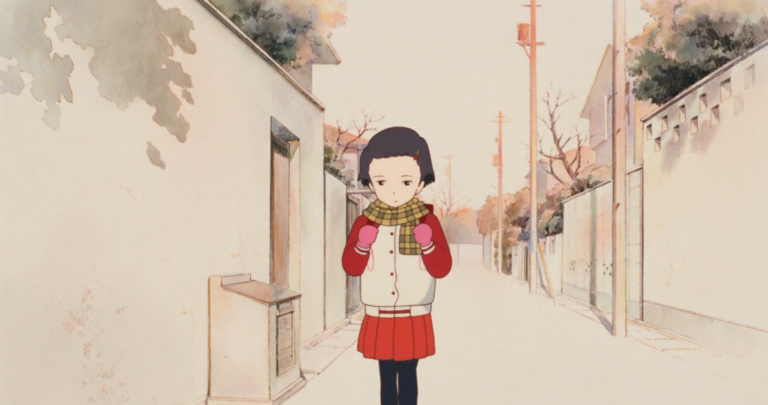There’s a lot of alcohol in this film that gets poured down our beloved kōhai’s throat. She, surprisingly, suffers from none of the ill effects of a drink too many. A bottomless pit as her stomach, she walks around a world that is fabricated on the fly – trains on rivers, street fires, underwear-stealing henchmen. Once you’re steeped into this extemporaneous narrative, you begin to feel that all that alcohol that went gushing down her throat has now ended up in your belly. It’s frightening how much Masaaki Yuasa can do with very little to go on. Though I say it with a lighter air, the whole film feels as if a band of animation enthusiasts decided to create the visual equivalent of being spun around like a stained t-shirt at 1600/rotations-per-minute. You might think of this as a wholly unpleasant affair. I assure you, it is anything but.
Let me try to explain this viewing experience by answering my own questions. Once your intention to push the medium is clear, how do you structure your narrative? You simply cannot shuffle across unrelated events because you risk losing your viewers. Should you instead make the narrative more drawn-out, the wings you wish to attach to the medium cannot take to the heights of exploration. Sitting down to crack this is already a hard ask – and a hard sell if you’re looking to bankroll this. Once you’re done sweating the question to no avail, you decide to make the film with no narrative. This, ultimately, would have been a somewhat suitable assumption. But the acerbity of the humor – and sometimes even its very wackiness – belies the wry smile of a writer who pored over it. Since it is known that the film was adapted from Tomihiko Morimo’s book of the same name, my gut instincts, sadly, have no purchase. Even if Morimo may have never thought of it as he nudged his characters across Kyoto’s night, his spontaneity marries into – rather conveniently for Masaaki Yuasa – the experimental ebb-and-flow of the film.
But what exactly is being experimented on here? Metaphors, for a start. “An ocean of books,” we hear kōhai say, “and I am a deep-sea fish sweeping for quarry.” When you read and even when you write, you play the game of perfection in your mind by trying to animate the scene down to the last word. The little marble on the carpet, the stray sea shell cutting wet sand, a snake coiling around the lowest branch of a tree. The joys of reading exist in printing your version of those words inside your head – and metaphors hand-hold your brain as it strokes. In conventional animation, despite the existing possibilities, the narrative often doesn’t permit a single act of metaphorical allusion as it may risk a tonal shift that undoes the narrative. But Yuasa’s film is all about tickling that forbidden nerve. With a wafer-thin narrative, the animation of the film lends so much dimensionality to each frame – as when kōhai downs glass after glass at Rihaku-san’s table, the yellow elixir of nightlife coating her interiors and exteriors with color. Who knew that you could visualize the sensation of some fresh whiskey kicking down the ratty doors of your brain?
Despite all its devilishly charming flourishes, the film’s refreshing quality borrows much from the fact that it champions the desultory perspective of youth. There are no didacticisms, no moral takeaways, and the uncertainty of each passing hour can only be cured by outdoing the antics of that which has passed. The Sophist’s vanguard sets out to find the off-market Imitation Denki Bran with our kōhai at its head – and they end up at Rihaku-san’s train. Sat squarely, prepared to drink until their livers tap out, they eye the glass that’s in front of them. Alcohol, to our two competitors, represents different shades of life. For Rihaku-san, it reassures nothingness. For kōhai, it promises vitality. Yellow, resplendent, and endless in the production of joy seems acrid, stale, and exacting as it passes back and forth. As ludicrous as the circumstances of this competition may seem, it manages to pass on, precisely because of its unsophistication, the maxims of untrammeled youth. “I’ve neglected the discipline of male-female diplomacy,” she later appraises her life. She’s walked wherever her feet have led her without heeding what was most proximate to her. It’s here that the film, for its part, does what it needs to do – it doesn’t trip her guilt but brings her neglect ever so softly to her awareness. I scratch my head to ask – when was the last time a film so obstinate in being juvenile succeed in bringing out the contrast between age and adolescence as mere states of mind? I can only smile not knowing.
Honestly, though this question might be absurdly utilitarian, what is the point of even undertaking such a venture? Why do we even need films like this? Though the artist in his self-defense may brush it off as exercising creative license, the viewer might let the question linger. The way I see it, Yuasa has done something of remarkable interest – instead of letting the narrative shape the vision, he’s allowed the vision to shape the narrative. It might sound odd considering this is an adaptation, but the differences between text and film derive largely from the latter’s concrete, unified vision in each frame. Any film adaptation, for this reason alone, will be distinct from its source. There is no chapterization and the plotlines are picked willy-nilly as the filmmaker already has a global view of the film. So, much like building wings as you fly, the film is constantly placing and intermeshing events, the vision guiding what occurs next. This is evident in how every sequence in the film is visually more exuberant than the previous. The already loose screws left in place are juddered out in the final passages as kōhai finally goes to meet senpai – and not by coincidence. The only way to verbalize what transpires in those moments is by likening it to animating every little butterfly in your stomach. This is truly an experiment that pushes story-telling bounds and possibly gives us new ways to drill into the minutiae of everyday feelings.
Speaking of the final passage, the rapid pace that it gathers almost leaves you in a vacuum without time. Reaching fever-pitch, senpai shouts to a room of thousand self-images: “The more we analyze our own will, don’t we become incapable of moving forward?” Isn’t that what the film, without being explicit, strives to showcase? That the night is short, the crowds don’t wait, and the god of old book-markets isn’t always there to personally deliver the book that you wanted to read. Your reasoning doesn’t comfort you on your deathbed, the smaller moments whose importance evades you do. In imitating life’s haphazardness, the film oddly gains a philosophical face that it didn’t need to forcefully paint. Though I’ve hammered in this observation already, I can’t help but say it again – by not trying hard, by letting finer details dictate the narrative direction, Night is Short, Walk on Girl becomes a satisfying pleasure watch. The kind that I’d watch with a bowl of chips, a can of beer, and an old t-shirt that doesn’t mind getting stained. All while waiting for it to hit me with some lovely realizations about life.





